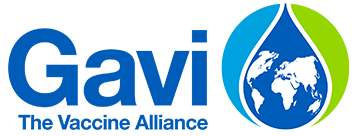A-Z of GAVI successes and challenges - Seth Berkley’s mid-term review
Accountability
When we entered this period from 2011-2015, it was the first time we had a five-year strategy. We had clear objectives, we had 18 key performance indicators (KPIs). This is our opportunity to take a look at progress two years in.
It’s very important to us that we are as transparent as possible. We are the stewards of our donor’s resources: the dollars, the pounds, the yen, and so we were delighted that just this last week, a major report was released on aid transparency. In this report, we’re ranked second in the world.
Targets
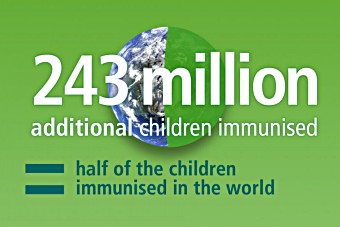
Four million future deaths averted: how do you picture those numbers. One way to do is to look at what it means in other circumstances.
Four million is equivalent to all of the babies born each year in the United States. We also talked about 243 million additional children immunised. That is half the children immunised in the world during this time period.
Measuring performance
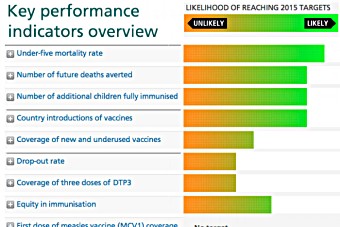
What we’ve tried to do here is take a look at the KPIs and assess how likely we think it is that we will meet them by 2015. Obviously things can happen between now and 2015, but what you can see in the green is that for most of our indicators we think it’s quite likely that we’re going to meet those goals. There’s a few for which it’s not the case and we are working hard to change the way we work on those.
Mission goals
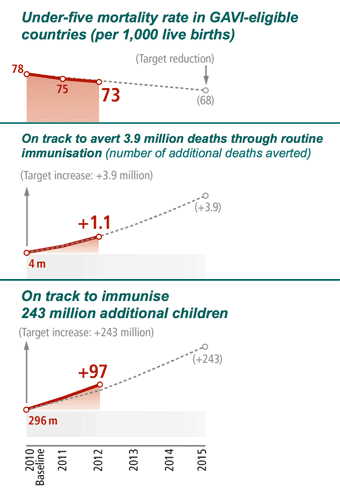
We have these large mission goals and the first one is under five mortality rates in GAVI-eligible countries. We’re on target. Many things affect child mortality not just immunisation, but immunisation is one of the most cost effective and successful interventions.
The other two mission indicators: 3.9 million deaths averted through routine immunisation and you can see again we’re on track for this. One question people might ask is why is it that the curve heads up and the answer is that as we immunise more children, more and more countries roll vaccines out.
The third indicator of 243 million additional children immunised: you can see that we’re actually above this right now.
Acceleration of vaccine introductions
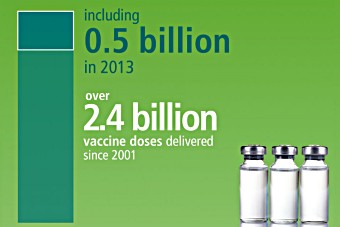
Since GAVI began, and you look at every vaccine that we’ve ever done, we’ve actually rolled out about a fifth of all the vaccines during this year, and about a quarter of all the launches that have occurred in the 13 years of GAVI occur this year.
In fact we’re doing more. 106 million people up until now have been reached through campaigns, 84 million through meningitis campaigns and another 22 million through yellow fever campaigns. That’s on top of the immunisations that we promised [Note: refers to 2011-2012].
Funding
91 percent of pledges have become signed agreements – that’s one of our KPIs. And the countries that haven’t are trying hard. Just yesterday, my country, the United States, managed to get their contribution of 138 million dollars in the bank bringing their contributions to over one billion dollars to GAVI. One of our challenges is that these last set of pledges get turned into signed agreements and obviously capital.
Private sector partnerships
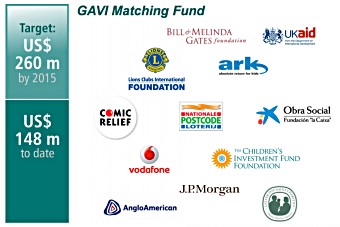
The Matching Fund brings in not only money but expertise from the private sector. We have many examples of working with innovative partnerships that will make a huge difference. The Lions Club: 1.35 million volunteers on the ground helping with immunisation. These are innovative partnerships that will make a huge difference.
Countries sharing the cost of vaccines
You can see that we’ve had increasing amounts of co-financing from countries. To talk about an ambitious goal, this level is set at 100 percent. We’ve hovered between 86 and 93 percent. In development I don’t know of any other example that is as ambitious as this.
More affordable vaccines
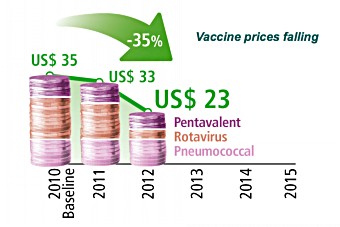
We’ve seen prices fall. In the last two years, prices have fallen 35 percent for the three key vaccines. This is a reduction of cost for the donors. It’s also going to be a reduction of costs in the future. We’ll continue to see these prices fall.
Pentavalent success story
At the time this period started (2011), pentavalent had been in 65 countries. It’s moved now to 72 countries. There’s only South Sudan left, which of course wasn’t a country when this period started. We’re excited that South Sudan is on track for the first quarter in 2014 to rollout this vaccine. This is an extraordinary achievement.
Women and girls
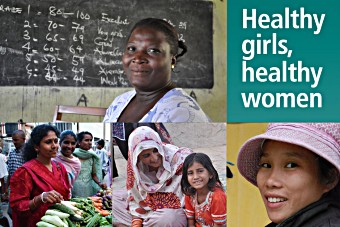
We’ve also started to bring forward vaccines that were targeted specifically at women and girls. In the short period that we have begun to discuss human papillomavirus vaccines and begun to have programmes, 25 countries have stepped up to the plate and said we want this vaccine. This is a really important addition.
Equity
Equity is a very important part of what we do. Our partners, UNICEF and WHO, have really stepped up to the plate. We’ve invested significant more finance in trying to deal with the lower coverage countries, putting in country tailored approaches, also in the countries that have the largest inequities. We have a plan as we always do at GAVI to try and tackle the problem.
Working with the Global Polio Initiative
One other big intervention that’s occurred during this period is the work with the Global Polio Initiative, to take advantage of the science they have in management and to work with them in trying to look at routine immunisation. This is Uttar Pradesh, and here you can see a mapping of looking at immunisation rates by polio staff. Working with other partners is critical to the type of success that we want.
Sustainability
We have to sustain the work that we’re doing. Sustainability relates to many different issues: legislation, budget lines, national financing, political commitment. Today, 62 of the GAVI countries have budget lines for routine vaccines.
Beyond the promise
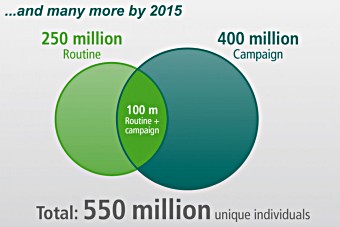
We are on track for the big mission goals but it isn’t only what we promised to do. We’re actually going to immunise an additional 400 million children through campaigns, meaning 550 unique individuals. This is extraordinary.
Dr Seth Berkley was CEO of Gavi, the Vaccine Alliance from 2011–2023.
